|
| |
-
This page contains pictures and information about Gall-inducing Scale Insects in family
Eriococcidae that we
found in the Brisbane area, Queensland, Australia.
-
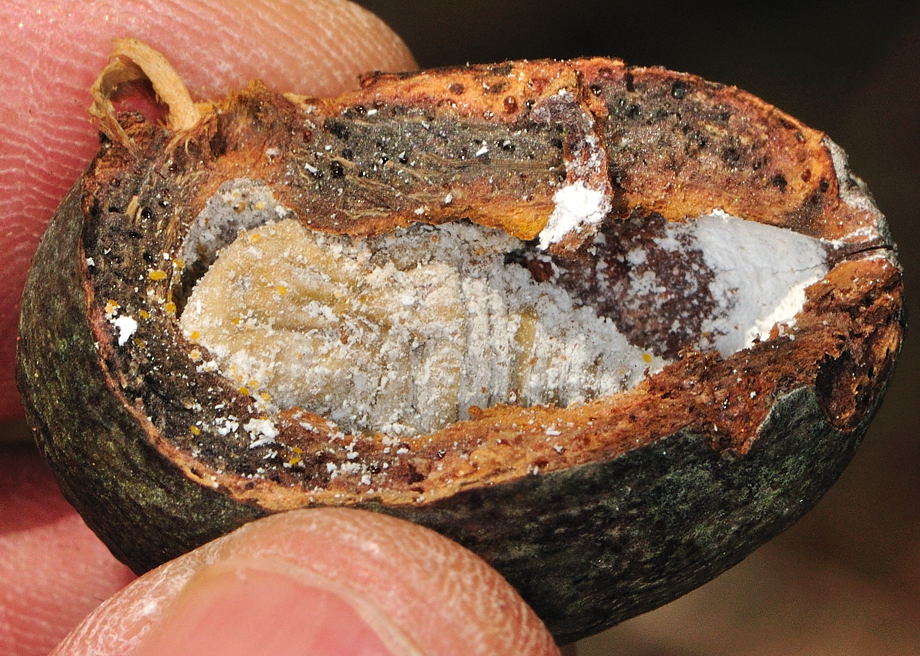 - Female
adult inside gall
-
- There are many group of insects evolved the habit of inducing galls on plant. They include the gall
midges, gall wasps and gall-inducing scale insects. The multiple independent origins of galling may
suggest a selective advantage of this gall-inducing
habit.
The most special group is this gall-inducing scale insects in family Eriococcidae. Eriococcid gallers
induce complex galls on plants. Sexual dimorphism of gall-inducing is apparent among Eriococcid species. Each
species induces different gall shapes which are recognizably species-specific. Female induces large woody
gall (20-40mm) on stem resembling fruits but not found on that host plant.
Males inhabit
much smaller galls (no more than 10mm long). Male's tubular galls are mostly
found on leaves The shape of the gall is
independent of the host-plant species and the host-plant organ on which the gall grows but determined by the species
and sex of the scale insect.
Apiomorpha is the largest genus in Eriococcidae. They are only found in
Australia. It is an Australian endemic genus except one species
found in Papua New Guinea. All of them induced galls on Eucalyptus species. Most of them exhibit host-plant preferences for certain
Eucalyptus species.
Adult females are long-lived. Most live over three years as adults and some live over five years. In
contrast, adult males are inconspicuous, short-lived, and restricted seasonal occurrence. Adult males
rarely live more than a day or two after leaving their gall.



- Gall with apical orifice
Crawlers in
chamber
Male's gall on leaf
-
-
The Eriococcid's galls are easily recognised because there is a small apical orifice through which the
female can eliminate her waste honeydew and also mate with male. Her offspring or first-instars nymphs,
called crawlers, make their exit from the maternal gall through this same opening and then disperse to
initiate new galls.
The gall-inducing scale insect each have a chamber. In which the insect has limited mobility and is
oriented with its head towards the base of the gall and its lobes towards the apex. The adult female has
reductions in legs, antennae and test-secreting glands that are associated with living in a gall.
Additionally, the heavily sclerotised and modified anal lobes of adult females may act as protection
against parasitoids and predators attempting to enter the gall.
The wingless adult females spend entire lives on a single host plant and oviposit there. Adult males are
short-lived and weak-flying. Dispersal is due to the movement of the crawlers, which usually
remain on their natal host if conditions are favorable.
Most species females are able to produce thousands of offspring over weeks. The body
cavity of gravid females is almost entirely filled with developing embryos. Apiomorpha is ovoviviparous and nymphs
are born fully developed. The first-instars nymphs usually remain grouped at the base of the gall chamber
for up to several days before emerging from the gall. Crawler emergence was recorded from different times
throughout the year. Reproduction does not appear to be seasonal.
The crawlers wandered over plants for up to seven days. Some crawlers display
dispersal behaviour of congregating at the tip of plants. The crawlers are the primary dispersers and appear well suited to
air-borne dispersal. The crawlers have flattened, oval to subcircular bodies fringed with a
continuous row of marginal setae. In addition, the surface area of each marginal seta is extended by a thin sheet of
waxy secretion. Some crawlers have been reported to orientate downwind and stand on their hind legs with
antenna and fore legs outstretched.
Development to adulthood takes from 2.5 months to over 9 months, depends on species. They did not
reproduce in the absence of males and thus reproduction in these species appears to be exclusively
sexual.
Females of Apiomorpha have three instars stages and male have five, which is quite standard in coccid.
Fire is quite common in Australia Eucalyptus forest. It is believed that the thick wall of the galls is
an adaptation for fire protection.
They are subject to the parasitoids by wasps - dark-tailed wasp Cameronella in Pteromalidae which make a
single large exit hole on gall wall. Or small parasite wasps which make many small exit holes. Their
predators include birds such as cockatoos and parrots. The evidence is that those predators remove one
side of the gall.
-
Genus Apiomorpha - Gumtree Gall
- Genus Apiomorpha is confined to Eucalyptus, on which it
forms distinctive galls. The galls induced by female and male are very
different. Female induces large woody gall on stem while male induces small
tubular gall on leaves.
-
- Two-tailed Gumtree Gall

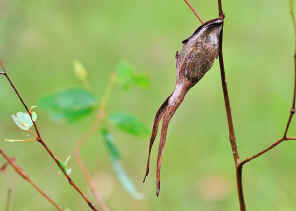 - Apiomorpha duplex, gall length 20mm
- This species induces the world largest gall. It is attached to the twigs
of Eucalypt. It forms a four-sided chamber continuous with two long
tails. The female inside is up to 30mm in body length. Please check this page
for more information.
-
-
- Four-horned Gumtree Gall

 - Apiomorpha munita, gall length 20mm
- Female matured gall is four-sided and has either 3 or 4 horns
projected from each top corner. Live gall is green in colour. Please check
this page for more information.
-
-
- Spindle Gumtree Gall
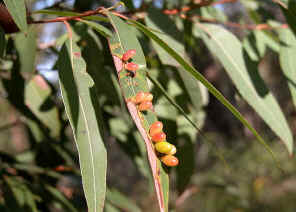
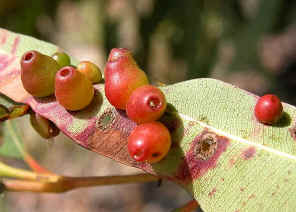
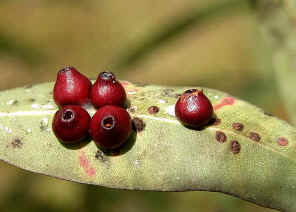 - Apiomorpha spinifer, gall
length 5-10mm
- The insects in family Eriococcidae induce gall on gum leaves. Please check
this page for more information.
-
-
- Bishop's Head Gumtree Gall
-



- Apiomorpha pileata, female gall length 25-35mm
male gall
- Female insects induce large gall on stem of gumtree which look like a
bishop's head. Males' galls are much smaller than females'. They are either
on stems, leaves or on gall of females. Check this page
for more pictures and information.
-
-
- Egg-shaped Gumtree Gall


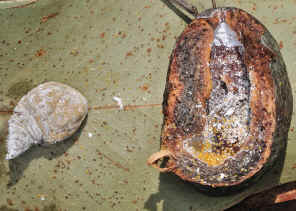 - Apiomorpha conica, gall
length 5-10mm
- Pictures were taken in Karawatha Forest on Oct 2010.
-
-
- Large Gumtree Gall
-



- Apiomorpha variabilis, gall
length 40mm
- This gall is very large in size. The gall is structurally complex with
inner and outer capsules separated by air space. Check this page
for more pictures and information.
-
-
- Stem Gumtree Gall
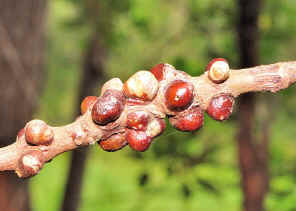
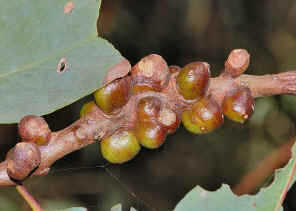
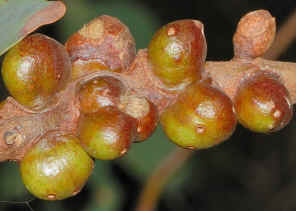 - Apiomorpha sp., gall
length 5mm
-
-
- Stem Gumtree Gall
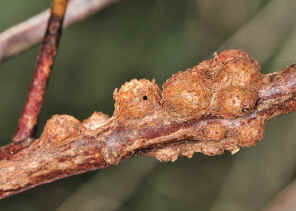 - Apiomorpha sp., gall
length 5mm
-
-
- She-oak Gall, Casuarina Gall
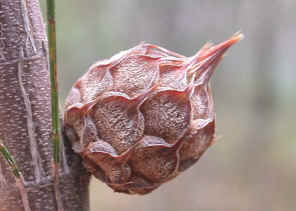
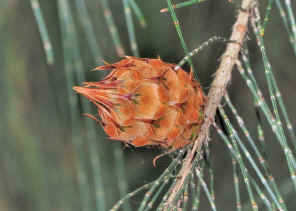
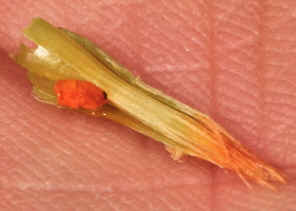 - Cylindrococcus spiniferus, gall diameter 15mm
- We easily found this gall on She-oak tree. There could be one or two galls
on every stems. We used to think they are the flowers or fruits of the
plants. Checking the reference books and found that they are gall induced by
insects. Opened the gall and found the little fellow inside. We have more
information and pictures in this page.
-
- Reference:
- 1. A
field guide to insects in Australia - By Paul Zborowski and Ross
Storey, Reed New Holland, 1996, p86.
- 2. Insects of Australia and New Zealand - R. J. Tillyard, Angus
& Robertson, Ltd, Sydney, 1926, p174.
- 3. Insects
of Australia - CSIRO, Division of Entomology, Melbourne University
Press, 2nd Edition 1991, p 461.
- 4. Family ERIOCOCCIDAE
- Australian Biological Resources Study, Australian Faunal Directory.
- 5. The response of gall-inducing scale insects (Hemiptera: Eriococcidae: Apiomorpha Rübsaamen) to the fire history of mallee eucalypts in Danggali Conservation Park, South Australia.
by Y P. J. GULLAN, P. S. CRANSTON & L. G. COOK, Trans. R. Soc. S. Aust. 121(4), 137-146, 28 November, 1997.
- 6. Penny J. Gullan Publications - Books and articles in refereed journals, Gullan and Cranston Lab, UC Davis.
- 7. Longevity and reproduction in Apiomorpha Rübsaamen (Hemiptera: Sternorrhyncha: Coccoidea) - Cook, L.G. and Gullan, P.J. (2002), Bollettino di Zoologia agraria e di Bachicoltura, series II, 33(3): 259-265.
- 8. Gall induction has evolved multiple times among the eriococcid scale insects (Sternorrhyncha: Coccoidea: Eriococcidae) - Cook, L.G. and Gullan, P.J. (2004), Biological Journal of the Linnean Society 83: 441-452.
-
- Back to top
-
- [ Up ] [ Psyllidae ] [ Aphididae ] [ Margarodidae ] [ Pseudococcidae ] [ Eriococcidae ] [ Dactylopiidae ] [ Coccidae ] [ Diaspididae ] [ Other Soft Bug families ] [ Unknown Galls ]
| |
|



























